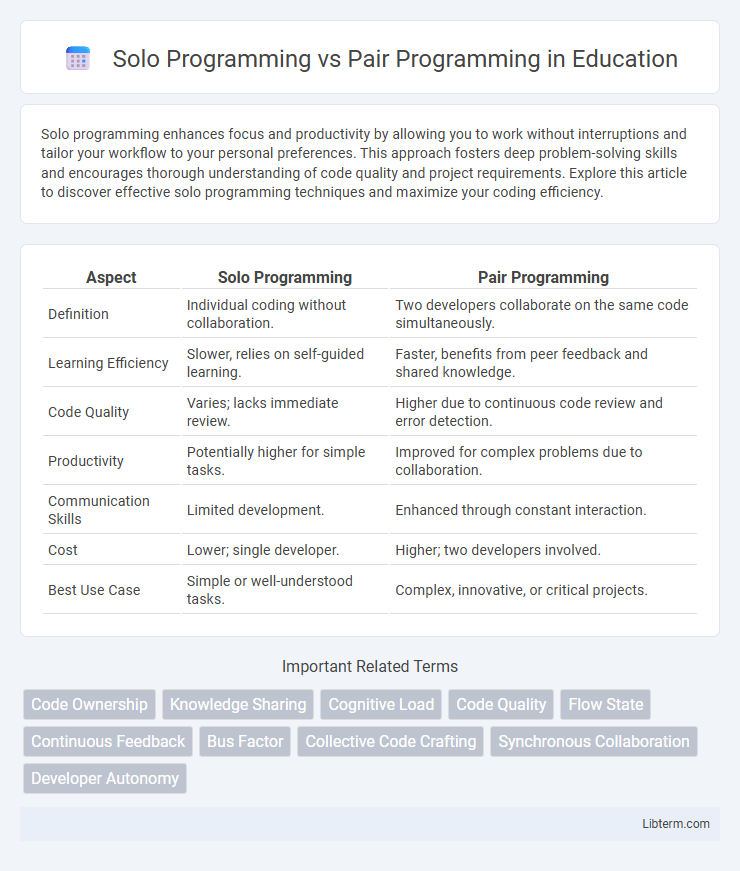Solo programming enhances focus and productivity by allowing you to work without interruptions and tailor your workflow to your personal preferences. This approach fosters deep problem-solving skills and encourages thorough understanding of code quality and project requirements. Explore this article to discover effective solo programming techniques and maximize your coding efficiency.
Table of Comparison
| Aspect | Solo Programming | Pair Programming |
|---|---|---|
| Definition | Individual coding without collaboration. | Two developers collaborate on the same code simultaneously. |
| Learning Efficiency | Slower, relies on self-guided learning. | Faster, benefits from peer feedback and shared knowledge. |
| Code Quality | Varies; lacks immediate review. | Higher due to continuous code review and error detection. |
| Productivity | Potentially higher for simple tasks. | Improved for complex problems due to collaboration. |
| Communication Skills | Limited development. | Enhanced through constant interaction. |
| Cost | Lower; single developer. | Higher; two developers involved. |
| Best Use Case | Simple or well-understood tasks. | Complex, innovative, or critical projects. |
Introduction to Programming Approaches
Solo programming allows developers to work independently, fostering deep focus and personal accountability, ideal for tasks requiring uninterrupted concentration. Pair programming involves two programmers collaborating simultaneously at one workstation, which enhances code quality and knowledge sharing through real-time feedback and diverse problem-solving perspectives. Both approaches serve critical roles in software development, with solo programming boosting individual productivity and pair programming improving team communication and error reduction.
What is Solo Programming?
Solo programming involves a single developer writing code independently, allowing for deep focus and personal control over the coding process. This method enables individual accountability and faster decision-making, as the programmer manages all aspects of development without external input. Solo programming suits tasks requiring concentrated problem-solving and is often preferred for simple or well-understood projects.
What is Pair Programming?
Pair programming is a collaborative software development technique where two programmers work together at one workstation, simultaneously writing and reviewing code. One programmer, the "driver," writes the code while the other, the "observer" or "navigator," reviews each line for errors and suggests improvements in real-time. This method enhances code quality, facilitates knowledge sharing, and accelerates problem-solving through continuous communication and feedback.
Key Differences Between Solo and Pair Programming
Solo programming emphasizes individual focus and autonomy, allowing programmers to work independently on coding tasks with full control over decision-making and pacing. Pair programming involves two developers collaborating simultaneously, promoting real-time code review, knowledge sharing, and immediate problem-solving, often improving code quality and reducing errors. Key differences include collaboration level, communication requirements, and impact on productivity, where solo programming suits tasks requiring deep concentration, while pair programming excels in complex problem-solving and mentoring scenarios.
Pros of Solo Programming
Solo programming enhances focus by minimizing distractions, allowing developers to concentrate deeply on complex coding tasks. It fosters complete ownership of the code, which can lead to faster decision-making and greater creative freedom. Developers working solo often achieve higher productivity through personalized workflows and uninterrupted problem-solving sessions.
Pros of Pair Programming
Pair programming enhances code quality through continuous peer review, reducing bugs and improving design. Collaboration between two developers fosters knowledge sharing, accelerating skill development and problem-solving efficiency. This method also boosts team communication and accountability, leading to higher productivity and more maintainable codebases.
Cons of Solo Programming
Solo programming often leads to limited code quality and missed errors due to the absence of immediate peer review. This approach lacks collaborative brainstorming, resulting in slower problem-solving and missed alternative solutions. Solo programmers also face increased risks of knowledge silos and reduced code maintainability within teams.
Cons of Pair Programming
Pair programming can lead to decreased productivity due to constant communication and potential conflicts between developers. The practice may increase project costs and extend development time because two programmers are working simultaneously on the same task. Furthermore, mismatched skill levels or incompatible working styles often result in frustration and reduced code quality during pair programming sessions.
When to Choose Solo vs Pair Programming
Solo programming is ideal for tasks requiring deep concentration, individual responsibility, and when working on well-defined problems with minimal collaboration needs. Pair programming suits complex, high-risk projects demanding continuous code review, knowledge sharing, and immediate feedback to reduce errors and improve code quality. Choose solo programming for rapid, independent development and pair programming for team-oriented, collaborative problem solving.
Conclusion: Selecting the Right Approach
Choosing between solo programming and pair programming depends on project complexity, team dynamics, and desired productivity outcomes. Solo programming offers focused individual creativity and faster decision-making, while pair programming enhances code quality, knowledge sharing, and error detection. Balancing these approaches based on specific development goals and resource availability ensures optimal software engineering efficiency.
Solo Programming Infographic

 libterm.com
libterm.com